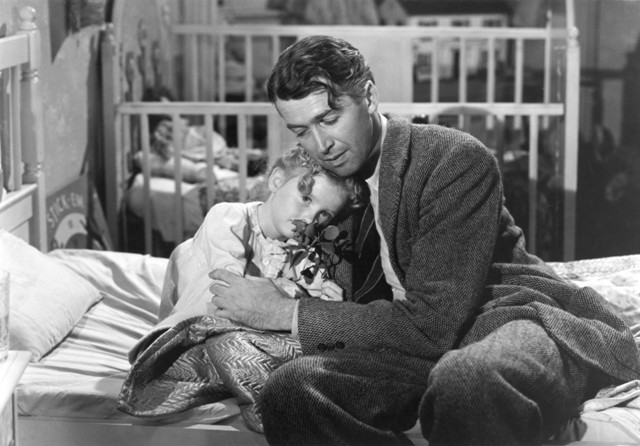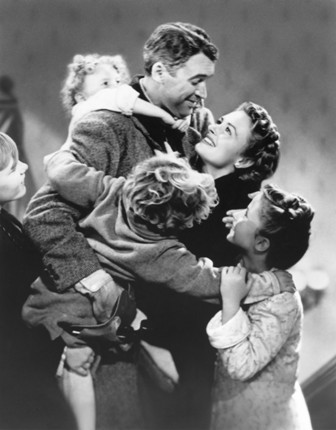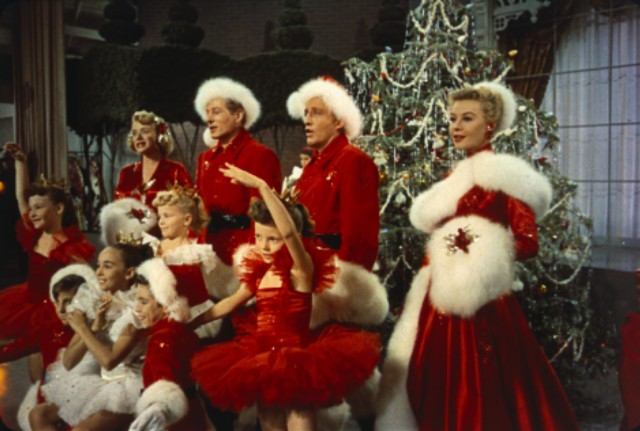CHICAGO – Patrick McDonald of HollywoodChicago.com appears on “The Morning Mess” with Dan Baker on WBGR-FM (Monroe, Wisconsin) on March 21st, 2024, reviewing the new streaming series “Manhunt” – based on the bestseller by James L. Swanson – currently streaming on Apple TV+.
Film Feature: ‘The 27th Annual Music Box Christmas Show’ Brims With Nostalgic Warmth
CHICAGO – The most memorable moviegoing experiences of your life are often circumstantial. They may depend entirely on the audience that you see them with. There are few things more magical than the moment when an ageless work of cinema manages to move and invigorate your soul, along with those of the surrounding audience.
That’s precisely the experience I had while attending the annual Music Box Christmas Show a few years ago. It’s impressive to see how much the event has grown over time, with its double feature of holiday classics now extended into a five-day marathon. In its twenty-seventh year, the show has become somewhat of a family affair. Returning audience members have been invited to submit photos of their past visits for inclusion in a pre-show slideshow. Young moviegoers (and the young at heart) will enjoy the intermission festivities where Santa Claus materializes and leads the audience in a series of carols. The films themselves even inspire a fair amount of audience participation, which actually enhances rather than detracts from their crowd-pleasing allure.
Though the Music Box Theatre could’ve easily chosen different holiday perennials to screen each year, they’ve consistently decided to stick with Frank Capra’s 1946 masterpiece “It’s a Wonderful Life” and Michael Curtiz’s 1954 centerpiece “White Christmas.” If “Life” is the real meat of the Christmas season, then “White” is the cheese…or perhaps the cheese whiz. Needless to say, the films compliment each other beautifully. One is an emotional powerhouse, the other is a campy delight, yet their appeal remains eternal, and has inspired me to take a closer look at their cinematic staying power.

Karolyn Grimes and James Stewart mend petals and hearts in Frank Capra’s It’s a Wonderful Life.
Photo credit: Paramount Home Entertainment
Like Maycomb, Alabama, the setting of Harper Lee’s equally immortal “To Kill a Mockingbird,” Bedford Falls is a fictional slice of Americana that cultivates a place in our collective imagination. As the small town that entraps the big dreams of good-hearted George Bailey (James Stewart) in “Life,” Bedford represented a hopeful yet not quite idyllic vision of our country that Capra not only believed in, but endorsed. His status as a Sicilian immigrant granted him somewhat of an outsider’s perspective on the American dream, which is beautifully reflected in the bittersweet Rockwellian optimism of his pictures. Audiences fresh off WWII weren’t quite ready to accept Capra’s uninhibited sentimentality back when “Life” premiered in 1946, and was quickly overshadowed by the timely Best Picture winner, “The Best Years of Our Lives.” Yet to the surprise of everyone (including Capra), “Life” has transcended the boundaries of time and taste, emerging as one of the most deeply loved motion pictures of all time.
Audiences have made a habit out of utilizing the film to recharge their batteries and reestablish their faith in human nature. The film is as affirming a holiday classic as Dickens’ “Christmas Carol,” and for many of the same reasons. Both stories enable their main characters to peer into an alternate dimension through the help of “divine intervention.” While Scrooge observes how people may be better off without his cold-hearted avarice, George realizes that he underestimated his worth to the town that he sacrificed his life to save. Instead of enduring three formidable spirits, George is accompanied by a lovably neurotic angel named Clarence (Henry Travers).
 Frank Capra’s It’s a Wonderful Life will screen at the 27th Annual Music Box Christmas Show. Photo credit: Paramount Home Entertainment |
Some first-time viewers are turned off by the film’s playful view of the afterlife, epitomized by a prologue in which we see blinking stars representing god and the angel, as they converse about the film’s troubled mortal protagonist. Yet the film’s lighthearted supernatural elements are merely a gentle framework for startlingly powerful human drama. One of the film’s unsung heroes is thirteen-year-old Bobbie Anderson (as the young George), who is the first member of Capra’s utterly impeccable cast to anchor the film emotionally.
In his third and final collaboration with Capra, Stewart delivers the performance of his career. It’s markedly different from his pre-WWII work, offering proof that his military service deepened his artistry. This is not the same fresh-faced youth who embodied the idealism of Mr. Smith, but a full-grown man haunted by his past and the dreams he failed to realize. What’s most powerful about the film is George’s ultimate acceptance of the fact that his life may not be the one he had in mind, but it is more wonderful and enriching than he could’ve ever dreamed.
Capra’s peerless sense of pacing injects the story with vibrant life as it hurtles from one scene to the next, resulting in some subtly sloppy editing (keep your eyes peeled for the reappearing wreath). Yet the film never feels rushed, and always slows down long enough for key moments to resonate, such as young George’s visceral encounter with Mr. Gower (H.B. Warner) or the mesmerizing moment when George and Mary (Donna Reed) wordlessly convey their complex feelings for one another while huddled around a telephone. And then there’s the overwhelmingly euphoric final sequence, which is one of the few in film history that makes me misty-eyed every damn time I watch it. I’ll never forget how the Music Box audience broke out into rapturous applause at the film’s final fade-out. They were cheering not just for the film, but for the belief in a dream that truly does seem, for that heavenly moment in the cinema, within reach.

Rosemary Clooney, Danny Kaye, Bing Crosby and Vera-Ellen are upstaged by precocious ballerinas in Michael Curtiz’s White Christmas.
Photo credit: Paramount Home Entertainment
In contrast, “White Christmas” has aged a great deal more over the years, despite the fact that it was an instant hit with audiences during its initial release. Though the legendary Irving Berlin provided the score, it is largely forgettable, save for the title tune, which first appeared in 1942’s “Holiday Inn.” “White” is technically a derivative follow-up to “Holiday,” but it is, I daresay, an improvement over its predecessor. It may not feature Fred Astaire with firecrackers strapped to his happy feet, but it thankfully also doesn’t include Bing Crosby decked out in blackface to celebrate Lincoln’s birthday. Crosby’s graceful baritone owes a large portion of its immortality to Berlin, whose brilliant song made the suave crooner an icon of the holiday season, and inspired Crosby’s wildly popular 1945 album “Merry Christmas.” Yet neither of the Berlin/Crosby film collaborations are all that remarkable, functioning more as nostalgic fun than memorable cinema. Curtiz’s film follows the “Hey Gang, Let’s Put On A Show!” formula, as song-and-dance duo Wallace (Crosby) and Davis (Danny Kaye) team up with a sister act, the Haynes sisters (Rosemary Clooney and Vera-Ellen), to save a drafty Vermont inn owned by the boys’ former general (Dean Jagger). Why? Because they love him, they love him….
 Michael Curtiz’s White Christmas will screen at the 27th Annual Music Box Christmas Show. Photo credit: Paramount Home Entertainment |
Jagger portrays the general as an affable old chum more grandfatherly than authoritative. I always love imagining the role filled by R. Lee Ermey, who would undoubtedly banish everyone to mamby-pamby land. The film is at its most hilarious when it pokes fun at Hollywood’s “Don’t Ask Don’t Tell” approach to concealing Kaye’s homosexuality. As the Donald O’Connor-style sidekick, Kaye easily steals the show, particularly when he’s allowed to be flamboyant. It’s blatantly clear that he has zero chemistry with his assigned love interest, Vera-Ellen, who always has a smile uncomfortably stretched on her face. In what is surely the film’s high point, Crosby and Kaye appear in drag and lip-sync to the Haynes’ rendition of “Sisters.” Kaye is clearly in his element, prompting a reaction of genuine amusement from Crosby, who spends most of the movie looking sullen. His romantic subplot with Clooney is even gloomier, since she proves to be a grouchy ice queen right off the bat. After a contrived misunderstanding, Clooney stomps away from the inn, inspiring sad-sack Crosby to run after her. In one of the film’s most laughably absurd moments, Crosby finds her literally a day later as the star of her own established show, wailing the self-pitying torch song, “Love, You Didn’t Do Right By Me.”
Is this film ridiculous? You bet. Is it irresistible cornball fun? Absolutely. As the first Hollywood spectacle shot in VisaVision, the film looks just smashing, with its candy-colored cinematography jumping right off the screen. An uncredited Bob Fosse dreamed up the film’s acrobatic, occasionally spastic choreography for Berlin’s most schizophrenic musical numbers. At least two songs in the film are set up and then swiftly abandoned in favor of an admittedly splendid yet thoroughly inexplicable Vera-Ellen dance number (such as the “Minstrel Show” tune that quickly devolves into “Mandy”).
Before I even heard of the Music Box Christmas Show, both of its films were an important tradition in my household. Every Christmas Eve night, my family and I would eagerly watch “It’s a Wonderful Life” with the same reverence that one would have when attending Mass. And every New Years Eve, my dad would force us to watch “White Christmas,” which we would laugh at in between mouthfuls of Cracker Jacks. In their own distinctive ways, these films are wonderful cinematic staples of the season, and they are all the more fun to watch in a room full of passionate fans. In this case, more is indeed merrier.
 | By MATT FAGERHOLM |


